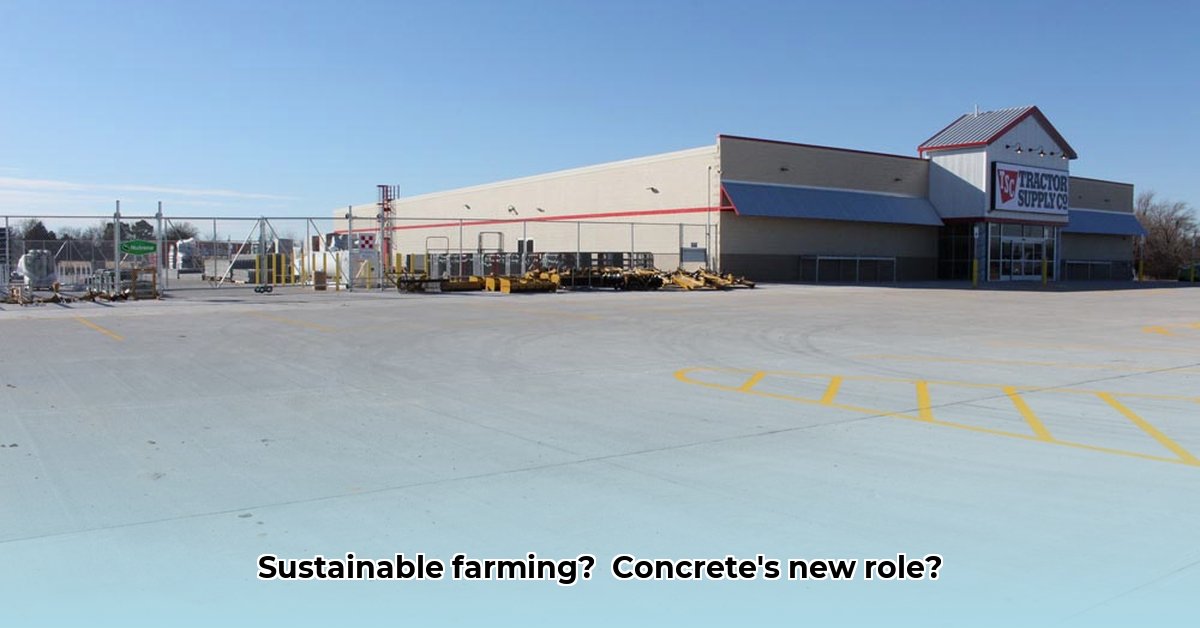
Tractor Supply Concrete Mix: Building a Greener Farm
Sustainable farming demands mindful material choices. Concrete, crucial for farm structures, presents an environmental challenge due to the significant greenhouse gas emissions from cement production. This article explores how to minimize concrete's environmental impact, focusing on responsible concrete use and exploring greener alternatives. We'll provide actionable steps for farmers, contractors, and policymakers to build eco-friendly farm structures.
For more local options, check out this Kentucky Tractor Supply link to local store.
How can we ensure our farms remain resilient while minimizing our environmental footprint? Cement production contributes substantially to global greenhouse gas emissions, posing a considerable obstacle to sustainable agriculture. The imperative isn't eliminating concrete entirely, but rather employing it responsibly. This is where strategic material selection and construction practices become vital.
The Concrete Challenge: A Heavyweight in Greenhouse Gas Emissions
Cement production significantly impacts global greenhouse gas emissions, a critical factor in climate change and sustainable farming. Building durable structures is essential, but minimizing environmental impact is equally crucial for the long-term health of our planet and agriculture’s future. The key is not if we use concrete, but how.
Smarter Concrete Choices: Making Tractor Supply Concrete Mix Work for You
While Tractor Supply concrete mix isn't inherently "green," strategic choices can lessen its environmental impact.
Low-Cement Concrete: Reducing cement content directly lowers greenhouse gas emissions. Opt for low-cement mixes, readily available at Tractor Supply and similar retailers. This seemingly small change significantly reduces overall impact.
Recycled Aggregates: Incorporating recycled materials—crushed concrete, glass, or certain recycled plastics—reduces reliance on newly mined resources, benefiting the environment. Check your local building supply stores for options.
Construction Efficiency: Meticulous planning minimizes waste. Careful calculations and material reuse significantly reduce the environmental burden. Choosing contractors with sustainable building practices is also beneficial.
Durable Structures: High-quality, long-lasting structures, while initially more expensive, minimize the need for repairs and replacements over time, reducing the overall environmental impact.
The Whole Picture: From Cradle to Grave (and Beyond)
Concrete's environmental impact extends beyond manufacturing. Consider its entire life cycle – from creation to disposal or repurposing. A durable structure lasting decades, even with higher initial resource use, may have a smaller overall carbon footprint per year of use than one requiring frequent repairs or early replacement. This “cradle-to-grave” approach is essential for accurate environmental cost assessment.
"Considering the entire life cycle – from material sourcing to disposal – is key to minimizing the environmental impact of any construction project," says Dr. Emily Carter, Professor of Chemical and Biological Engineering, Princeton University.
Working Together for Change: Actionable Steps for a Greener Farm
Sustainable concrete practices require collaborative effort. The following table outlines actions for various stakeholders:
| Stakeholder | Short-Term Actions | Long-Term Actions |
|---|---|---|
| Farmers | Choose low-cement concrete; minimize material waste; explore alternative materials. | Invest in durable structures; explore sustainable alternatives; support research into better options. |
| Contractors | Efficient building techniques; recycle and reuse materials; proper waste disposal. | Adopt sustainable practices; utilize eco-friendly materials; support research and development. |
| Policy Makers | Incentives for low-carbon concrete; fund research into sustainable materials. | Policies encouraging sustainable practices; strategies for waste reduction and material reuse. |
The Future is Green: Innovation in Sustainable Construction
The future of sustainable concrete in agriculture is promising, with ongoing advancements in low-carbon cement production and innovative alternative materials. Ongoing research is key to reducing impact while maintaining durability. Sustainable practices are essential for a changing agricultural landscape. Informed choices are paramount in the pursuit of environmentally responsible farming.
How to Reduce the Carbon Footprint of Concrete in Sustainable Agricultural Construction
Concrete's environmental impact requires multifaceted solutions. Here's how to reduce its carbon footprint:
Supplementary Cementitious Materials (SCMs): Materials like fly ash and slag reduce the amount of Portland cement needed, significantly lowering emissions. Studies show potential emission reductions of up to 50%.
Recycled Aggregates: Using recycled aggregates diverts waste from landfills and reduces the demand for new materials, minimizing embodied carbon.
Optimized Mix Design: Precisely calculating materials minimizes waste and lowers emissions. Careful planning significantly reduces impact.
Alternative Binders: Emerging technologies, such as geopolymers, offer potentially lower carbon footprints than traditional Portland cement. While still under development, they represent a promising future direction.
Governmental Incentives: Policies promoting sustainable building practices are crucial for wider adoption of greener options. Advocate for policies that support sustainable construction.
Consumer choices matter. Support builders and materials prioritizing sustainability to drive a more eco-friendly construction industry. Building a greener future is about creating a healthier planet for generations to come.